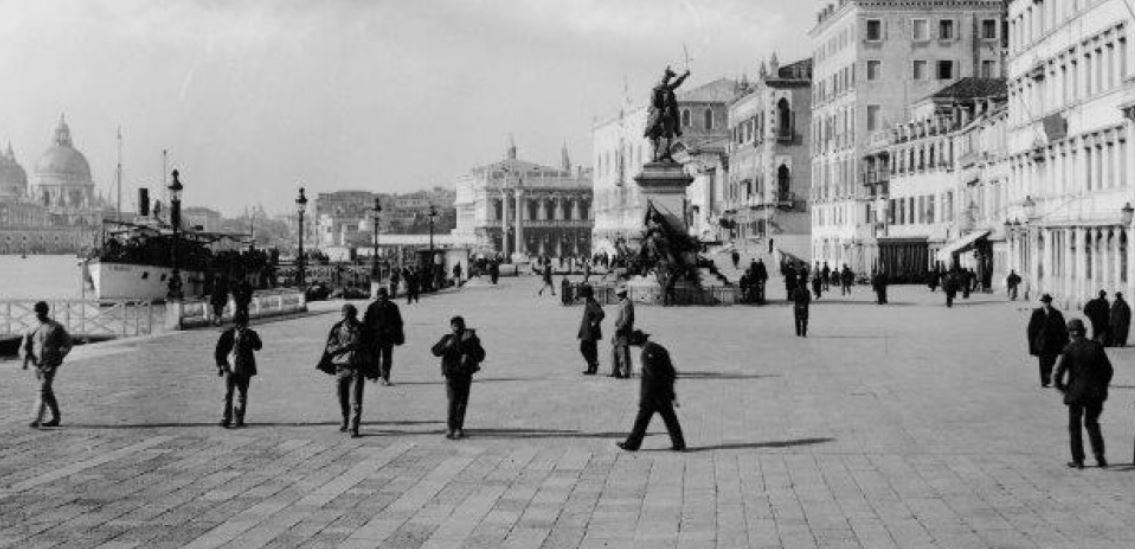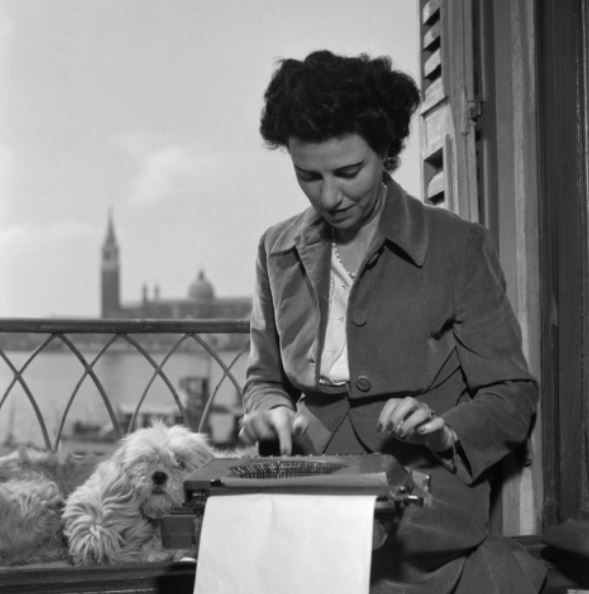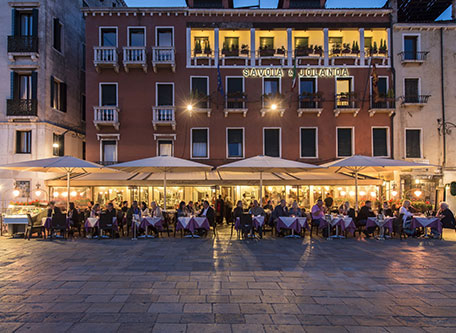Receive for Free - Discover & Explore eNewsletter monthly with advance notice of special offers, packages, and insider savings from 10% - 30% off Best Available Rates at selected hotels.
history
Discover Hotel Savoia & Jolanda, which is located right down the road from renowned historical landmarks like Ponte dei Sospiri (Bridge of Sighs), the Palazzo Ducale (Doge’s Palace), and the Basilica de San Marco (St. Mark’s Basilica).
Hotel Savoia & Jolanda, a member of Historic Hotels Worldwide since 2022, dates back to the 19th century.
VIEW TIMELINEOverlooking the Basin de San Marco in the Venetian Lagoon, the Hotel Savoia & Jolanda has been one of Venice’s finest holiday destinations for generations. In fact, the Hotel Savoia & Jolanda was among the first generation of hotels that helped create the foundations for Venice’s modern tourism industry. While historical records are scarce regarding the exact origins of the hotel, postcards from the early 19th century do exist that show the Hotel Savoia and Jolanda standing alongside the celebrated Riva degli Schiavoni. One prominent postcard even referred to the structure as the “Bavaria e Jolanda.” The name was an homage to the famous union between the Savoias—an Italian noble house—and the Duchy of Bavaria. (Founded some two centuries prior, the relationship was specifically forged when Princess Henriette Adelaide of Savoy married the prominent Ferdinand Maria, Elector of Bavaria, in 1650.) But the hotel’s name had been modified to “Savoia Hotel & Principessa Jolanda” by the beginning of the 20th century, before finally becoming the “Hotel Savoia & Jolanda” during the 1940s. By then, the Hotel Savoia and Jolanda had built a considerable reputation with its elite services and wonderful facilities. It had subsequently hosted numerous high-profile guests, including traveling dignitaries and socialites. Perhaps the greatest patron to visit the hotel was the prominent art collector Peggy Guggenheim in 1948. Guggenheim had specifically rented an extravagant suite while presenting her own collection of rare art at the prestigious XXIV Venice Art Biennale. Today, the Hotel Savoia & Jolanda continues to be one of the best places to stay in all Venice. Cultural heritage travelers in particular enjoy its fascinating heritage and luxurious amenities. Indeed, this impressive historic hotel is mere moments away from celebrated historical landmarks like the Ponte dei Sospiri (Bridge of Sighs), the Palazzo Ducale (Doge’s Palace), and the Basilica de San Marco (St. Mark’s Basilica).
-
About the Location +
Located inside the famed Venetian Lagoon, Venice is a magnificent city defined by its venerable history. Visitors from throughout the world find its countless turquoise canals and unique brand of Italian architecture to be incredibly enchanting. A lack of readily available historical records have unfortunately made it difficult to determine exactly how Venice first came into existence, although many oral traditions present a number of interesting theories. Some origin stories posit that the first Venetians were refugees escaping the Trojan War, while others insist that the city emerged as a local hideout from barbarians amid the fall of the Roman Empire. Nevertheless, Venice became an important Mediterranean seaport within Byzantium, a Roman successor state based out of the ancient metropolis of Constantinople (now Istanbul). Despite their distance from the Adriatic Sea, the Byzantines managed to control the settlement via the Exarchate of Ravenna. Yet, the rulers in Ravenna often concerned themselves with other matters and allowed for an appointed official called the “Dux” or “Duke” to handle affairs on their behalf. The Venetian “Dux” evenutally became the more recognizable “Doge” after the city achieved a significant level of autonomy following the Lombard conquest of Ravenna in the 8th century. Over time, the Doge emerged as an elected office, with candidates selected from Venice’s leading merchant families. The Doge’s role in Venetian society became less dictatorial, too, as future generations of aristocrats instituted political checks and balances as their councilors.
Venice prospered over the next few centuries, becoming one of Europe’s most commercially affluent trading centers by the height of the Middle Ages. Its situation within the Mediterranean basin made it easy for Venetian merchants to trade with Byzantium, as well as the many Islamic kingdoms that resided in North Africa and the Middle East. As such, the city became a hub for the influx of exotic goods, traveling from places as far away as China along the legendary Silk Road. Venice’s great wealth also made it immensely powerful, both in terms of money and military might. In fact, Venice had grown so strong that the city was able to obtain its freedom from the Byzantines in 1082, with their former overlords even requesting the use of its now-formidable navy. But the true peak of Venice’s influence occurred in the wake of the Fourth Crusade, when Venice actually seized many of the eastern landholdings of the Byzantine Empire. The Venetians had agreed to ferry an army of Crusaders to Egypt as part of a grander strategy by Pope Innocent III to reconquer Jerusalem. But when the Crusaders could not pay their way across the sea, the Venetians struck a deal in which the knights would attack their enemies. First striking Zara (an area the Venetians lost to one of their rivals, the Kingdom of Hungary), the Crusaders eventually arrived off the coast of Constantinople to exact revenge against a deposed Byzantine emperor who had failed to pay his own debts. Sacking the city in 1204, the Venetians stormed off with countless riches, as well as more territorial gains across the Aegean Sea.
Now a major continental power, the Venetians proceeded to conquer rival Italian city-states, culminating with their defeat over the Genoans during the 14th century. At its apex, the Venetian empire even included large swathes of territory that currently constitutes the modern Italian province of Veneto. But Venice’s decline began soon thereafter once the Ottomans annexed the Byzantine Empire, thus dissolving its greatest trading partner. Furthermore, Portuguese sailors had successfully managed to navigate the Horn of Africa, enabling European mariners to bypass the Mediterranean Sea and its merchant republics. Venice’s continental landholdings began to disappear, as both the Ottoman Empire and the Papal States led victorious military campaigns that sought to erode its influence. (Venice did experience some success fighting back against its enemies—specifically the Ottomans—which it famously defeated alongside the Spanish at the Battle of Lepanto in 1571.) The historic Venetian Republic came to an ultimate end, though, when Napoleon Bonaparte conquered the city at the beginning of the Napoleonic Wars. Looted by pro-French forces, it subsequently became a satellite of Napoleon’s new empire until his first abdication in 1814. Venice was then integrated into the new Austrian Empire, before finally joining the modern Italian state in the 1860s amid the Wars of Italian Unification. Venice today is one of Italy’s foremost cities, home to all kinds of manufacturing operations—particularly shipbuilding. The city also features many outstanding historical landmarks, like the Ponte Di Rialto, the Basilica Di San Marco, and the Palazzo Ducale (the Doge's former palace). The heart of Venice is even protected as one of the United Nation’s celebrated UNESCO World Heritage Sites.
-
About the Architecture +
When the first proprietors of the Hotel Savoia & Jolanda constructed the destination, they decided to use elements of Classic Revival-style architecture into the designs. Also known as “Neoclassical,” Classic Revival design aesthetics are among the most common architectural forms seen throughout Europe. This wonderful architectural style first became popular in Paris, specifically among the architectural students who had studied at the French Academy in Rome during the late 18th century. Upon their return from the Italian Peninsula, the architects began emulating aspects of earlier Baroque design aesthetics into their designs, before finally settling on Greco-Roman examples. Over time, the embrace of Greco-Roman architectural themes spread across the continent, reaching destinations like Germany, Spain, and Great Britain. It found a particularly receptive audience among Italian architects, who relied upon the style to infuse a sense of heritage into their rapidly modernizing landscapes. Nowhere was this more common than in Venice, where Napoleon Bonaparte had destroyed much of its historical architecture during his occupation of the city in the Napoleonic Wars. In fact, Classic Revival-style architecture became a source for “venezianitá,” a habit in which local Venetians incorporated exaggerated components of native historical architecture as a means of protecting their shared past.
As with the equally popular Revivalist styles of the same period, Classical Revival architect found an audience for its more formal nature. It specifically relied on stylistic design elements that incorporated such structural components like the symmetrical placement of doors and windows, as well as a front porch crowned with a classical pediment. Architects would also install a rounded front portico that possessed a balustraded flat roof. Pilasters and other sculptured ornamentations proliferated throughout the façade of the building, as well. Perhaps the most striking feature of buildings designed with Classical Revival-style architecture were massive columns that displayed some combination of Corinthian, Doric, or Ionic capitals. With its Greco-Roman temple-like form, Classical Revival-style architecture was considered the most appropriate for municipal buildings like courthouses, libraries, and schools. But the style found its way into more commercial uses over time, such as banks, department stores, and of course, hotels. Examples of the form can be found throughout many of the West’s major cities today, including London, Paris, and New York City. Architects still rely on Classic Revival architecture when designing new buildings or renovating historic ones, making it among the most ubiquitous architectural styles in the world.
-
Famous Historic Guests +
Peggy Guggenheim, art collector known for founding the prominent Peggy Guggenheim Collection in downtown Venice.
Queen Margherita of Savoia, Queen consort of Italy (1878 – 1900)
Queen Elena of Montenegro, Queen consort of Italy (1900 – 1946)
King Umberto I of Italy, (1878 – 1900)
King Vittorio Emanuele III of Italy (1900 – 1948)
-
Women in History +
Peggy Guggenheim: Peggy Guggenheim is remembered today for her efforts to conserve countless works of modern Western art during the first half of the 20th century. As her name would suggest, she was born as a scion of the prominent Guggenheim family. But unlike her kin, Peggy abjured the world of business in favor of the arts. Guggenheim initially became engrossed with art during her time as a clerk with an avant-garde bookstore in mid-town Manhattan. She was soon fascinated with the area’s artistic community and relocated to Paris, France, in order to meet even more intellectuals. Guggenheim gradually crafted numerous friendships with some of the most influential contemporary artists at the time, including Constantin Brâncuși, Man Ray, Marcel Duchamp, and Romaine Brooks. She eventually promoted their talents and helped get their work exhibited. In fact, Guggenheim even began to showcase the artwork herself, opening a gallery called the “Guggenheim Jeune” in London. While she held a deep appreciation for all art, it was Surrealism that truly interested her.
As such, she began collecting countless pieces of surrealist art—an activity that only increased when Germany began conquering numerous European countries in World War II. Fearing the Nazis’ harsh censorship laws, Guggenheim purchased many forms of surrealist art to safeguard from potential destruction. Indeed, she would end up obtaining now priceless masterpieces from such renowned artists as Salvador Dalí, Pablo Picasso, and Max Ernst (who was also her husband at one point). She proceeded to exhibit the new artwork in a second gallery in New York City, which was known as “Art of This Century.” Once the war had ended, Guggenheim made the difficult decision to close her two galleries and become a museum owner instead. In 1949, she moved into a gorgeous 18th-century mansion along Grand Canal in Venice and devoted space to function as a museum for her impressive art collection. Guggenheim maintained the museum for the resort of her life, leaving it in the hands of the Solomon R. Guggenheim Foundation upon her death in 1979. Today, her fantastic museum carries on her legacy as the renowned Peggy Guggenheim Collection.




























